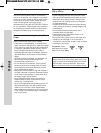
– 3 –
Microwave Recipe Preparation and Techniques
Menu Planning for
Microwave Cooking
How to Keep Everything Hot at The Same Time
Plan your meals so that the food will not all need
last minute cooking or attention at the same time.
The special features of microwave cookery make it
easy to serve meals with everything piping hot.
Cooking of some foods may be interrupted while
you start others, without harming the nutritional
value or flavour of either.
A recipe which requires standing time can be
microwaved first and another food cooked while it
stands. Dishes prepared in advance can be
reheated briefly before serving.
It does take some experience and time to cook with
confidence. Microwaves are fast so you will have to
do some experimenting. You might find you will use
your conventional range in conjunction with your
microwave oven. For example, while cooking the
roast in the microwave oven, you can be cooking
the vegetables and gravy on the range top. This
can also be done the other way around. Prepare
your meals as follows.
1. Firstly, cook the most dense item (roast or
casserole). Drain and retain meat juice from
joints then cover with foil.
2. Cook the potatoes, rice or pasta.
3. Cover with foil for standing.
4. Cook greens and other vegetables.
5. Cover with foil for standing.
6. Cook the gravy with the retained meat juices,
stock and thickening.
7. Carve the roast and serve the vegetables and
gravy.
While you are learning to plan meals, you may get
a bit behind time. Don’t worry. Dinner servings may
be reheated on Medium-High, for 1 to 2 minutes
per serving.
If you prefer not to use foil, cover food with
saucepan lids. A metal lid will retain the heat for at
least 15 minutes.
Meanwhile, how can you cook all the vegetables at
the same time? Simply place potatoes and pumpkin
in one dish and less dense vegetables such as
broccoli, cabbage, cauliflower, beans and peas in
another. Sprinkle greens with water. Cover with a
lid or plastic wrap. Cook on Medium-High for
cooking times refer to vegetable cooking chart on
page 20. Fresh and frozen vegetables can be
mixed on a vegetable platter, but remember frozen
vegetables are not as dense as fresh vegetables,
as they have been blanched before freezing.
If vegetables are cut to a similar size, they can be
cooked in separate ramekins or small dishes at the
same time.
Increasing & Decreasing Recipes
Increasing
• To increase a recipe from 4 to 6 servings,
increase each ingredient listed by half.
• To increase a recipe from 4 to 8 servings, double
each ingredient listed.
• For larger quantities of a recipe, a large dish
should be used. Make sure that the dish is deep
enough to prevent the recipe from boiling over
during cooking.
• Make sure to cover, stir or rearrange food as
directed in the recipe and always check the food
during cooking.
• Increase standing times by 5 minutes per 500g.
• Use the same Power Level recommended in the
original recipe.
• Increase the cooking times by:
1
⁄3 of original
cooking time for 6 servings; and an extra
1
⁄
2 of
original cooking time for 8 servings.
Decreasing
• To decrease a recipe from 4 to 2 servings,
decrease each ingredient listed by half.
• For small quantities, a small dish should be used.
Make sure that the dish is large enough to prevent
the recipe from boiling over during cooking.
• Use the same Power Level recommended in the
original recipe.
• Decrease the cooking times by
1
⁄2 to
2
⁄3 of the
original cooking time.
Cooking for One
• To decrease a recipe from 4 to 1 serving, quarter
each ingredient listed.
• A smaller dish should be used, making sure that
the dish is still large enough to prevent the recipe
from boiling over.
• Use the same Power Level recommended in the
original recipe.
• Quarter the original cooking times, then add extra
time, if needed.
• Make sure to cover, stir or rearrange food as
directed in original recipe and always check the
food during cooking.
Converting Recipes from
Other Sources
When the recipe is written with a wattage different
than your oven, adjust the cooking time by
approximately 10% per 100 watts, e.g. 6 minutes
would be adjusted by 36 seconds. Alternately,
adjust the power level by one level. If your wattage
is higher than the recipe: (1) Adjust time downward
or (2) Adjust power level downward. If your wattage
is lower than the recipe: (1) adjust time upward or
(2) adjust power level upward (when possible).


















